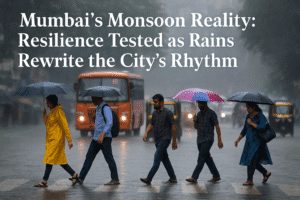Mumbai’s Monsoon Reality: Resilience Tested as Rains Rewrite the City’s Rhythm
Mumbai’s monsoon reveals stark contrasts: while northern suburbs like Borivali battle severe waterlogging, South Mumbai remains relatively unscathed—a testament to unequal urban resilience. Heavy rains cripple transit networks, flooding local trains and delaying flights, exposing systemic fragility. Yet amidst chaos, Tansa Lake’s overflow offers relief, securing the city’s water supply after summer shortages. The IMD’s orange alerts trigger preparedness but fail to prevent tragedies like Khindipada’s wall collapse, underscoring deeper infrastructure neglect.
Commuters navigate this duality—heroic adaptability against recurring disruption—as rains rewrite daily life. Ultimately, Mumbai’s downpours are less about weather and more about an annual stress test of planning and equity, demanding solutions beyond temporary fixes. The city’s spirit endures, but its future hinges on transforming vulnerability into sustainable adaptation.

While headlines scream citywide chaos, Mumbai’s true monsoon story lies in its stark geographic contrasts. Northern suburbs like Borivali and Malad battled knee-deep waterlogging within hours of downpours, yet South Mumbai’s streets remained merely damp. This isn’t just weather – it’s an urban planning report card. Older drainage systems in extended suburbs crumble under intense rainfall, while the island city’s colonial-era infrastructure holds firmer. The real takeaway? Rainfall maps now double as Mumbai’s socioeconomic cartography.
Transport Turmoil: The Commuter’s Endurance Test
Wednesday’s 25-minute train delays reveal a deeper truth: Mumbai’s lifeline bleeds during monsoons. As rainwater seeped into AC coaches, millions faced a commute that’s equal parts journey and endurance trial. Airlines scrambling with advisories underscore how one weather system can ripple across transport ecosystems. The lesson repeated annually: In Mumbai, arrival times are aspirations, not appointments, between June and September.
Water Wisdom: The Silver Lining in Every Cloud
Amidst the chaos, Tansa Lake’s overflow at 5:40 PM offers poetic balance. This critical reservoir – now holding its full 145,080 million-liter capacity – means parched summer memories will fade. For a city that rationed water just months ago, every overflowing lake is a climate blessing in disguise. Mumbai’s relationship with water remains beautifully contradictory: it’s both the deluge we dread and the scarcity we fear.
The Orange Alert Paradox: Preparedness vs. Paralysis
The IMD’s orange alert triggered textbook responses: travel warnings, civic teams on standby. Yet the Khindipada wall collapse that buried homes behind Omega High School exposes systemic cracks no alert can fix. When hillside settlements with questionable structural integrity face 215mm rainfall (like Kasapuri), warnings become Band-Aids on landslide wounds. True safety requires rethinking urban sprawl, not just issuing alerts.
Mumbai Monsoon Handbook: Beyond Umbrella Advice
Forget generic “carry rain gear” tips. Mumbaikars need tactical wisdom:
- Train Travel: Follow @CentralRailway for coach flooding alerts
- Flight Strategy: Check runway conditions (not just flight status) via Mumbai ATC handles
- Local Navigation: BMC’s real-time waterlogging map trumps “routes to avoid” lists
- Home Safety: Hill-adjacent residents should note IMD’s 3-hour nowcasts, not daily forecasts
Tomorrow’s Forecast: Infrastructure or Resilience?
As Thursday’s orange alert looms, the real question isn’t “how much rain” but “how much longer?” Mumbai’s spirit shines through drenched commuters sharing auto-rickshaws and shopkeepers offering shelter. Yet heroism can’t replace hydrology. When lakes overflow while streets flood, it’s nature’s ironic reminder: The city that masters water management will own its future.
This monsoon season isn’t just weather – it’s Mumbai’s annual audit of resilience, exposing where we stand between adaptation and surrender. The true measure won’t be in millimeters of rain, but in millimeters of progress before next July.
You must be logged in to post a comment.